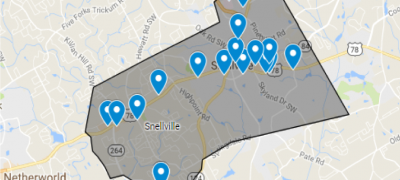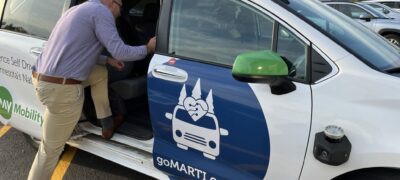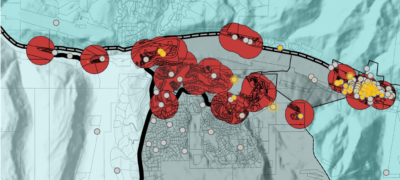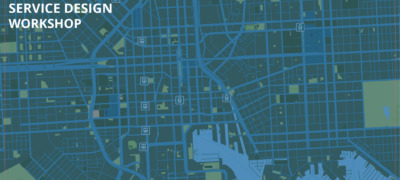Microtransit is a wide-ranging concept that can take many forms. What you hope to accomplish affects the design, or flavor, that you choose. In part 2 of N-CATT’s microtransit webinar series, we talk to experts and operators of varying flavors of microtransit to give an overview of how different models serve different agency goals.
Unfortunately we experienced technical difficulties during this webinar and do not have a recording available. We do have slides, and will update Q&As on this page as they come in. Our apologies for the inconvenience.
Q&A
- How do traditional paratransit costs compare to your microtransit service?
- Paratransit and microtransit have very similar operating costs
- Is corner to corner the only option for microtransit, and do people with disabilities have a more of a curb-to-curb option within that model?
- With corner to corner, I can’t say definitively, but I’m pretty confident that that’s just a set of our zones, not based on users. But you’d probably have to ask the vendor for a definitive answer on that, in terms of geographies.
- I think one thing I’ll add to that is because we’re going through right now that process of designing specific. We will have some specific pickup and drop-off areas. Via has been good about coaching us through, you have your key destinations, and you probably have specific places where your bus is going to do best to pick up and drop off. Let’s set that as a pin, so that people don’t just want to be picked up anywhere at Wal-Mart but at this specific place at Wal-Mart where, that works well for your operations and makes sense as a customer waiting area. I would say that you can do a blend, I guess, is what I’m saying, depending on the location, if not by the customer. It’s also likely that once you have the software set up, it will start with automatic stop recommendations and then you can adjust them as you need to based on safety and other factors.
- Do you have any recommendations based on the type of density or geography that would make a better or worse fit for the types of zones that you have done? No, add on to that after.
- It’s a good solution for us in places where the streets, sidewalks, and pedestrian infrastructure is not as good, although I wouldn’t want to represent it as a panacea. I mean, when you go and draw the zones you want to decide do I want to be on this side of the road, or that, we have a lot of rural roads where I’m like, I don’t know if I want to allow a customer to be picked up on this side of the road. I don’t see a safe way to get there. I think it’s an improvement over the fixed route. You can get back into some neighborhoods and stuff where people wouldn’t be able to get into and out of very easily on foot. But it’s not a silver bullet or anything.
- How are you analyzing or how do you plan to analyze whether people are using Micro transit as a feeder or to duplicate or compete with the fixed route? Are there ways that you’ve tried to incentivize one versus the other?
- It’s not as scientific as I’d like for sure. Our software provides, you’ve got heat maps and little density maps that are pretty powerful. But I think you’ll find they won’t necessarily answer those questions the way you’d like them answered. We’re doing surveys right now to ask people if it hadn’t been for this, would you have ridden fixed route or would you have driven or using this as a feeder or not? We sadly don’t have that quantified yet but we’re hoping to get that quantified and break that down by zone. But a lot of it right now is more anecdotal, unscientific, you go in and you watch the buses moving around, you talk to the dispatchers, you talk to the operators. Our Franklin zone in South Sacramento, the second zone I talked about is probably one where we’ve had the most debate about redundancy with a fixed route. It’s a pretty long service area. You can ride it from one end to end. It’s redundant of a trip on light rail that’s five or six stations. People do that. We’ve talked about splitting that zone in half so that people can make that trip. But if you’re going to split it in half, okay, what happens to that person that lives on one side of the border or the other. They’re not going to like that. That’s going to be hard to explain. At the same time, that zone, has lots of little pockets here, they’re all over, where there are neighborhoods full of seniors or disadvantaged that really can’t get to the bus too easily. I mean, they can call Paratransit, but is that what you want them to do? The use case, we think, is to help those people get to transit. Big picture, as I said, I mean, people aren’t using it to go from Elk Grove to Folsom, 15 miles or something, so.
- For the trips that are on the Uber or Yellow Cab, connecting to transit, have you seen anything about anyone deciding they’ll just take the taxi the whole way in instead of transferring to the bus?
- Yes, we had some worries about that because the first zone that we did, one of the hubs that we use is a mall, because we have four bus routes that converge, and we have a high-quality bus stop and everything. It’s an obvious choice for us for a hub. But at the same time, we were like, why don’t they just going to use it to go all the way to the mall. We just really don’t see that. The trip pattern is still mostly commuting periods. That was, again, that was the fixed route that we were replacing. I was surprised that we didn’t see more of that. But it hasn’t played out. I think that as our zone gets bigger, as we’re proposing to do, that was something that could happen. But at the same time, they’re not talking about a large number of trips. I don’t see it as really breaking the bank or anything. I mean, if people need to make the trip, and it works for them, then that’s why we’re here.
- If our listeners here are thinking about microtransit, what would you recommend as a good starting point for people to consider getting together or, what are the first steps?
- I mean for us, it was really about considering who is your user and thinking through, what is the trip type that they’re going to want, and what are the needs that they have in terms of their vehicle type needed, they can use a mobile booking platform and some of those things.
- What do you have for existing technology? Can it be upgraded relatively simply, and what’s your organizational capacity for innovation?
- Yes, and I don’t know if it’s the first question, but maybe the question you might not think about, I closed in my slides about who is going to be dispatching this. For us, we also use our call center people. They double as reservationists. You’re always going to think about, okay, this is directly operated versus mass. We’re going to have to do procurement. We are going to have to get it funded. But I would encourage folks to give some thought to who’s going to staff? What are their hours? When do they clock in? Who do they report to?
How are we doing? We’d love to receive feedback through our Customer Survey



